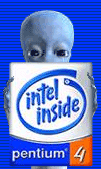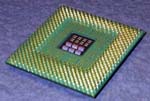|
A larger image of the
Intel Northwood P4 CPU is posted here (760x624, 28KB). Notice how
the chip itself is well protected beneath the hard shell casing, making
is nearly impossible to damage. The casing design makes heatsink installations
a snap.
Update 10feb2004 - Before we go much further, you should know that the
Northwood has been superceded by Intel's next-generation Pentium 4 CPU:
the Prescott. For info about this new chip see here:>
Intel Prescott
Pentium 4 CPU. Now we'll get back to the Northwood.
Note that you used to be able to purchase
two different socket-478 P4's today. But one of them was not
a Northwood. The Northwood Pentium 4 is based on the new
.13-micron die Tualatin core (smaller, 146mm² in size),
with copper interconnects (which are tiny wires or 'traces' that connect
transistors).
By contrast, older P4s were based on the 0.18-micron
Williamette core (larger, 217mm²), with aluminum interconnects.
See here
for an image (61KB) that illustrates the difference in size between
the old & new P4 CPUs.
The Northwood's smaller transistors are able to switch faster
and generate less heat than previous, hotter-running P4s. This
allows the Northwood P4 to reach higher clock-rates than its
larger, Williamette-based P4 cousin. Note Chris' comments from
his Northwood
review at GamePC:
Northwood runs extremely cool, considering its massive
clock speeds. With the retail Pentium 4 cooler, at a default clock
speed of 2000 MHz, the Northwood maxed out a temperature of 89.5°F.
In comparison, our Willamette P4 ran well over 100°F.
Northwood P4s overclock
well, especially with their lower (1.5v default) voltage. Lower
voltage means reduced power consumption and less heat generated, which
translates into improved stability.
The Williamette-based 2GHz P4 is rated at 75.3 watts. Far as
I know, this is the highest-rated TDP (Thermal
Design Power) of any CPU. The 2GHz Northwood P4 is rated
at 52.4 watts (see here).
The 2.2GHz Northwood is rated at 55.1 watts. [You know that a
60-watt light bulb burns cooler than a 100-watt bulb.]
Preliminary reviews indicate that a 2.0GHz Northwood P4
has a good chance of reaching (being overclocked to) 2.5GHz,
which corresponds to an increase of 25% over the default clockrate.
The 1.6GHz denomination is virtually assured to reach 2.1GHz.
In terms of overclockability, this makes the Northwood P4 (especially
the 1.6A) another Celeron
300a. The C300a was a legendary Intel CPU of yore, known for its
ease of stable overclocking, rendering $500 performance for ~$125. People
are already referring to the 1.6A (~$138)
at the new Dancing Queen, cuz it does the dance (overclocks)
so reliably to speeds averaging 2.3GHz. Note Chris'
comment regarding overclocking a 2.0GHz Northwood P4
(3rd paragraph):
"When we say stable, we mean it too. We were
able to run through a set of benchmarks at 2.5 GHz without a single
crash. In fact, our testbed is still running right now at 2.5 GHz.
That's a 25% overclock without any external modification to the chip
or motherboard!"
The first Intel Northwood Pentium 4 CPUs have been released
in 2.0 and 2.2 GHz flavors. Rumor
has it that Intel will also (later) release a 1.6
and 1.8GHz Northwood. It's looks like they're already available.
Intel is differentiating the Northwood P4 from the it's older
Williamette cousin by adding
the letter 'A'. Where the P4 is concerned, that little
'A' means A_lot. If you order a 2.2GHz P4 CPU,
you're assured that it's a Northwood, cuz there are no
Williamette-based 2.2GHz P4s.
Intel P4 CPU's that end with the letter 'A' are designed
to run at 400-MHz system bus. CPU's that end with the letter 'B'
are designed to run at 533-MHz. And newer CPU's that end with the letter
'C' run at 800-MHz system bus.
Intel is sneaky about the way they name their CPUs. The
most obvious name changes rarely correspond to the most meaningful design
changes. Rather, the most desirable design improvements (e.g. die size
reductions) are often obscured by subtle name changes (like adding the
letter 'a', for example).
This means that you must do your homework if you want to select the
CPU that represents the best combination of performance, stability,
longevity & value. Gone are the days when buying the latest processor
was a safe bet.
For example, most people don't know that you can't directly compare
clock-cycles (MHz) of the Pentium 3 with those of the Pentium 4.
A 2GHz P4 does *not* process twice the number of instructions
of a 1GHz Pentium 3. If you think that Intel will ensure you
know this, you're mistaken.
Key features of the Intel Northwood Pentium 4 CPU in a nutshell:
- 0.13-micron die Tualatin core [old P4 = .18-micron Williamette]
- 146mm² core size with copper interconnects [old P4
= 217mm² with aluminum interconnects]
- 512KB L2 cache [old P4 = 256KB]
- socket-478 (pin) packaging [old P4 = both socket-423 &
-478 packaging]
- 1.5v default core voltage [old P4 = 1.70v and 1.75v]
- Contains 55 million transistors [old P4 = 42 million]
- 8KB super-fast L1 cache [old P4 = same, P3 has 16KB, but not the
super-fast stuff]
- 64-bit quad-pumped 100MHz FSB (effective 400MHz) [old P4
= same]
- 2 double-pumped ALUs (Arithmetic Logic Units)
do the work of four, running at twice the processor core speed [old
P4 = 2 single-pumped ALUs]
- No
support for dual-processor system configurations
- DDR-SDRAM chipset support scheduled for Q1 2002 [old P4 = same]
- uses Rambus DRAM [old P4 = same]
- 144 new SSE2 instructions [old P4 = SSE2, but not these 144 new
ones]
- 20-stage pipeline [old P4 = same, P3 = 10-stage]
- uses NetBurst technology instructions [old P4 = same]
- new ATX 2.03 spec for mounting heatsink retention fittings [same]
- requires additional 12-volt 2x2
power supply connector [same]
You can purchase power
supplies designed specifically for Pentium 4 systems. I asked
the folks at PC Power & Cooling, "What's different about
Pentium4 power supplies?" You can read their response, which
is posted here.
Intel discusses P4
power supply requirements here.
Word on the street is that not all socket-478 motherboards
will require a new case or power supply unit (PSU). Some reviews
claim that Asus
includes an adapter kit so that you won't have to buy a new case or
PSU, for system upgrades.
Most people who have already built P4-based systems claim that
you don't need a new case, but that you should get an ATX 2.03-compliant
P4-approved PSU. Enermax also makes a nice 470-watt P4-compatible
power supply you can buy for $99
[EG475P-VE-SFMA].
Pentium 4 motherboards are larger than P3 boards, so
make sure your case is big enough to accept the larger P4 boards.
I have a friend
with a P4 system (a home system, not a stripped-down benchmarking
rig). He claims that it's "rock solid". When I heard the way
Joshua said the words rock solid (including unprintable, colorful
adjectives), I knew that the Northwood would be my next CPU.
Another review posted here
echoes Joshua's sentiments.
Perhaps I should note that I'm not necessarily an Intel fan.
Rather I'm a stability
fan. And Intel chipsets rule the stability world. I'd
gladly pay extra for a stable system (within reason, or course). My
current system (Intel-based) is rock solid, even tho it's overclocked.
Kyle
at [H]ard|OCP seems to agree by saying (next-to-last paragraph):
Intel components still are the pinnacle when
it comes to building a problem-free system that we can rely on.
Chris
at GamePC seems to concur (first paragraph):
Our particular market, the high-end / gamer segment,
seems fairly split, many loving the raw speed and low price of the
Athlon, while others love the well-endowed memory bandwidth and ultra-stability
of the Pentium 4 platform.
To be clear, I seek maximum stability, with maximum performance
at a minimum price. In that order. Speaking of minimum price
...
|

